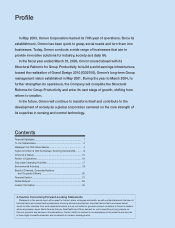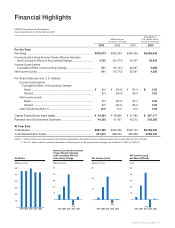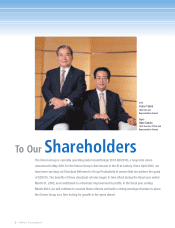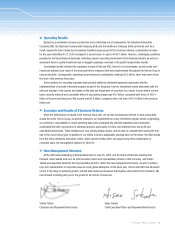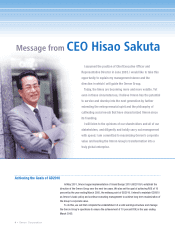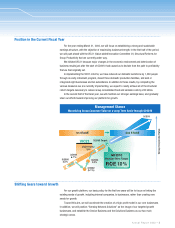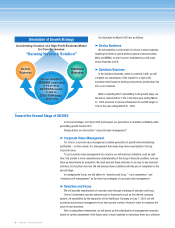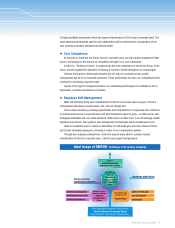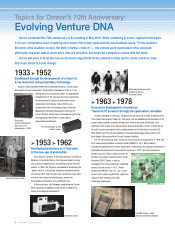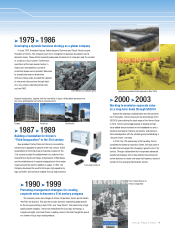Omron 2003 Annual Report Download - page 5
Download and view the complete annual report
Please find page 5 of the 2003 Omron annual report below. You can navigate through the pages in the report by either clicking on the pages listed below, or by using the keyword search tool below to find specific information within the annual report.
➤ Operating Results
Backed by a worldwide recovery in production and a bottoming-out of consumption, the Industrial Automation
Company (IAB), the Electronic Components Company (ECB) and the Healthcare Company (HCB) performed well. As a
result, despite the loss of sales due to business transfers made as part of the structural reforms, consolidated net sales
for the year ended March 31, 2003 increased 0.2 percent year-on-year to ¥535.1 billion. However, challenging conditions
persisted in the Social Systems Business, reflecting a severe operating environment in the financial industry as well as a
downward trend in capital investment due to sluggish passenger revenues in the public transportation market.
Consolidated profits reflected the expansion in sales of IAB and ECB, Omron’s core businesses, as well as the cost
reductions achieved as a result of the structural reform measures that were implemented throughout the Omron Group to
raise productivity. Consequently, operating income improved considerably, totaling ¥32.3 billion, more than seven times
the level of the previous fiscal year.
Omron posted non-operating expenses that included additional retirement payments associated with the
implementation of an early retirement program as part of the structural reforms; impairment losses associated with the
sale and disposal of idle assets; and losses on the sale and impairment of securities. As a result, income before income
taxes, minority interests and cumulative effect of accounting change was ¥4.7 billion, compared with a loss of ¥25.4
billion in the previous fiscal year. Net income was ¥0.5 billion, compared with a net loss of ¥15.8 billion in the previous
fiscal year.
➤ Execution and Results of Structural Reforms
Given the deterioration of results in the previous fiscal year, we carried out structural reforms to raise productivity
across the entire Omron Group. As specific measures, we implemented an early retirement program aimed at rightsizing
our workforce; consolidated or closed operating bases and reassigned the affected businesses and employees;
accelerated the shift of production to overseas factories, particularly in China; and withdrew from low-profit and
unprofitable businesses. These initiatives are now yielding steady results, and we plan to complete them during the first
half of the current fiscal year. In addition to our efforts to build a sustainable earnings base for the future, the R&D results
from the Omron Keihanna Innovation Center, which opened in May 2003, will support long-term maximization of
corporate value, the management objective of GD2010.
➤ New Management Structure
At the 66th General Meeting of Shareholders held on June 25, 2003, and the Board of Directors meeting that
followed, Hisao Sakuta took over as chief executive officer and representative director of the Company, and Yoshio
Tateisi was appointed chairman and representative director. Under this new management structure, we aim to achieve
long-term maximization of corporate value as a truly global enterprise. In this fiscal year, Omron will shift from structural
reform to the stage of business growth, and will take numerous measures that together will transform the Company. We
look forward to sharing with you in the growth of the Omron of tomorrow.
Yoshio Tateisi Hisao Sakuta
Chairman and Representative Director Chief Executive Officer and Representative Director
Annual Report 2003 • 3


